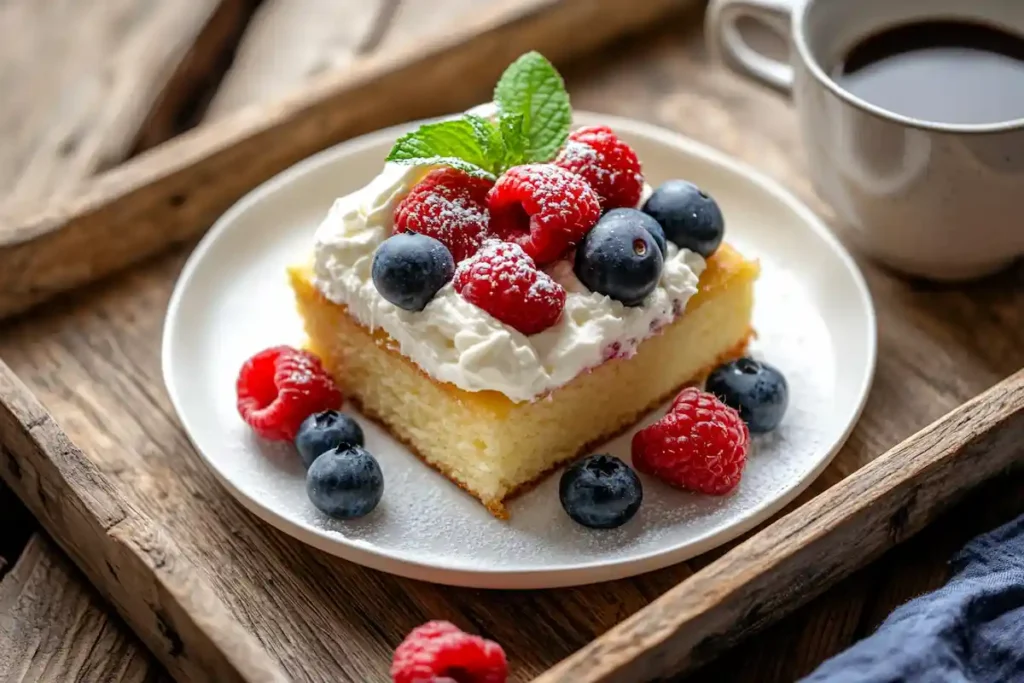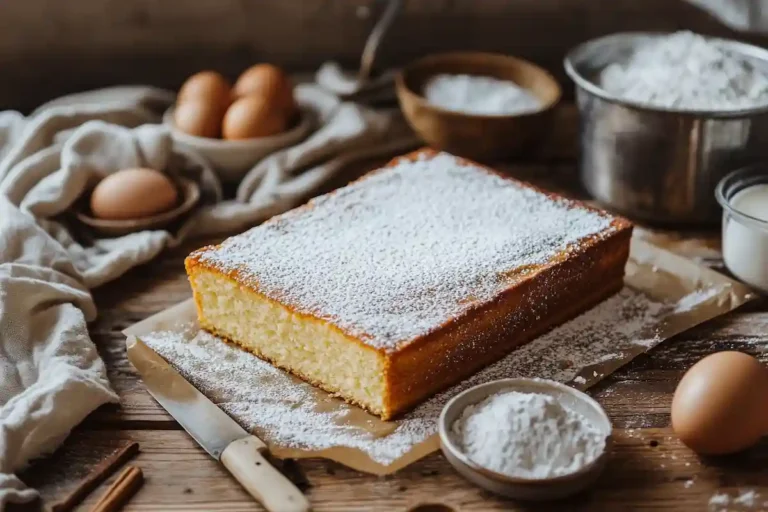Delving into the world of Kefir Sheet Cake is like unlocking a treasure chest of baking wonders. This delicious, moist dessert is not just a treat for the taste buds but a testament to the magic of kefir in the kitchen. In this guide, we’ll explore everything from the health benefits of kefir to step-by-step instructions on making the perfect sheet cake. Along the way, we’ll troubleshoot common baking issues and answer your most pressing questions. By the end, you’ll be ready to whip up a Kefir Sheet Cake that’ll leave everyone asking for seconds!
1. Introduction to Kefir Sheet Cake
What is a Kefir Sheet Cake?
At its heart, a Kefir Sheet Cake is a simple yet versatile dessert baked on a flat, rectangular tray. This format makes it perfect for serving a crowd, whether for birthdays, potlucks, or casual family dinners. The real star, though, is the kefir—a tangy, fermented milk product teeming with probiotics. Unlike traditional sheet cakes, this one boasts a moist crumb and a subtle tanginess, thanks to kefir’s unique properties.
The Unique Role of Kefir in Baking
So, what makes kefir such a game-changer in baking? For starters, its slightly acidic nature works wonders with baking soda, creating a chemical reaction that yields a light, fluffy texture. It’s also packed with probiotics, which can subtly enhance flavor complexity. And let’s not forget its ability to keep your cake super moist—no dry bites here!
Kefir isn’t just a one-trick pony, either. It can easily replace buttermilk, sour cream, or yogurt in recipes, making it a versatile ingredient to keep in your fridge.
Why Choose a Sheet Cake?
Sheet cakes have earned their spot as a go-to dessert for good reason. They’re easier to bake and serve than layered cakes, requiring less time and effort without sacrificing flavor or presentation. A Kefir Sheet Cake takes this convenience a step further by delivering maximum moisture, taste, and health benefits—all in one easy-to-make dessert.
With its flat surface, a sheet cake also offers a blank canvas for creative toppings, from whipped cream and fresh fruits to decadent chocolate ganache. It’s the kind of dessert that lets you shine, whether you’re a seasoned baker or just starting out.
2. The Benefits of Baking with Kefir
Health Benefits of Kefir in Baking
Using kefir in baking offers more than just culinary perks—it also contributes to a healthier lifestyle. This probiotic-rich ingredient introduces beneficial bacteria to your diet, which can improve gut health and support digestion. For anyone seeking a wholesome dessert option, a Kefir Sheet Cake offers an ideal blend of indulgence and nutrition.
Kefir is also known for its natural vitamins, like B12 and K2, along with minerals like calcium and magnesium. These nutrients enhance overall well-being and can make your baked goods feel like a nutritious treat. Whether you’re baking for kids, health-conscious friends, or simply yourself, kefir desserts check all the right boxes.
Nutritional Information (Per 100g)
Below is the approximate nutritional breakdown of Kefir Sheet Cake:
| Nutrient | Amount (Per 100g) |
|---|---|
| Calories | 250 kcal |
| Protein | 4 g |
| Fat | 12 g |
| Carbohydrates | 32 g |
| Fiber | 1 g |
| Sugar | 18 g |
| Calcium | 50 mg |
| Iron | 1 mg |
Improved Texture and Moisture in Cakes
Ever wondered why some cakes feel so soft they practically melt in your mouth? That’s kefir working its magic. Its acidity activates baking soda, creating air bubbles that give your cake a lighter texture. This process is particularly noticeable in Kefir Sheet Cake, where the even, moist crumb is unmistakable.
Additionally, kefir acts as a natural humectant, retaining moisture to keep your cake fresh for days. Unlike cakes that dry out quickly, those made with kefir remain deliciously tender.
Flavor Enhancements with Kefir
The subtle tang of kefir adds depth to baked goods, making them stand out. In a Kefir Sheet Cake, it balances sweetness with a hint of acidity, creating a rich yet delicate flavor. It’s versatile too—pair it with vanilla, chocolate, or citrus for an elevated taste.
3. Key Ingredients for Kefir Sheet Cake
Essential Ingredients for a Perfect Kefir Sheet Cake
Making a flawless Kefir Sheet Cake starts with the right ingredients. You’ll need staples like flour, sugar, eggs, and butter or oil, but kefir is the game-changer. Ensure you’re using fresh, plain kefir for the best results.
For those looking for a healthier twist, consider whole wheat or gluten-free flour. And if you’re making a frosting, cream cheese pairs wonderfully with the tanginess of the cake.
Choosing the Right Type of Kefir
Not all kefir is created equal! While plain, unsweetened kefir is ideal for baking, flavored varieties can add an extra layer of taste. Experiment with lemon or vanilla kefir for a fun spin on traditional recipes. Just ensure the kefir is not overly sweetened, as it can affect the balance of your cake.
Substituting Other Ingredients with Kefir
Kefir is the ultimate multi-tasker. Need a buttermilk replacement? Kefir’s got you covered. Running low on yogurt or sour cream? Kefir steps in seamlessly. Even milk can be swapped out in recipes, making kefir baking a flexible option for any pantry.
Internal linking opportunities from Smart’s Recipes could include pairing this article with guides on other baked goods or desserts featuring unique ingredients, such as the Egg White Burger Buns Recipe for a healthier baking twist.
4. Step-by-Step Guide to Making Kefir Sheet Cake
Preparation: Tools and Ingredients
Before diving into the recipe, gather your tools and ingredients to make the process seamless. You’ll need a mixing bowl, whisk, spatula, and a baking tray (preferably a 9×13-inch pan for the perfect sheet cake). Preheat your oven to 350°F (175°C) to ensure even baking.
The key ingredients for a Kefir Sheet Cake include:
- 2 cups of all-purpose flour (or a gluten-free alternative)
- 1 cup of plain kefir (regular or low-fat)
- 1 cup of sugar
- ½ cup of butter (softened) or oil
- 2 large eggs
- 1 tsp of baking soda
- A pinch of salt
Optional: Add a splash of vanilla extract or a teaspoon of lemon zest for a flavor boost.
Mixing and Combining the Batter
Start by creaming the butter and sugar together until they’re light and fluffy. This step ensures your Kefir Sheet Cake has a tender crumb. Gradually add the eggs, mixing well after each one.
In a separate bowl, whisk together the dry ingredients—flour, baking soda, and salt. Slowly incorporate this mixture into the wet ingredients, alternating with kefir. This method keeps the batter smooth and lump-free.
Baking Tips for an Evenly Cooked Cake
Pour the batter into your prepared baking pan, spreading it evenly with a spatula. Tap the pan gently on the counter to release any trapped air bubbles. Bake for 25–30 minutes, or until a toothpick inserted into the center comes out clean.
For optimal results, keep an eye on the cake during the last few minutes. Overbaking can dry out your dessert, which would undermine kefir’s moisture-boosting qualities.
Cooling and Decorating the Cake
Once baked, let the cake cool in the pan for 10 minutes before transferring it to a wire rack. A cooled cake holds its shape better and is easier to frost.
Decorating options are endless! A light dusting of powdered sugar works for a simple presentation, while cream cheese frosting or chocolate ganache can elevate the flavor profile. Fresh berries or nuts make excellent toppings for extra texture and appeal.
5. Variations and Creative Twists
Flavor Variations: Chocolate, Lemon, and More
One of the best things about a Kefir Sheet Cake is its adaptability. You can tweak the flavors to suit any occasion or craving. For a rich, indulgent twist, add ½ cup of cocoa powder to the batter to create a chocolate version. Lemon lovers can fold in some zest and juice for a citrusy delight.
Other fun ideas include swirling fruit jam or Nutella into the batter before baking. These additions not only taste great but also give the cake a marbled appearance.
Using Alternative Sweeteners and Flours
Want a healthier version? Swap out refined sugar for alternatives like honey, maple syrup, or coconut sugar. For those with dietary restrictions, almond or oat flour can replace traditional flour, though you may need to adjust the amount for consistency.
These substitutions make the Kefir Sheet Cake versatile and accessible to more people, without sacrificing taste or texture.
Seasonal Decorations and Add-ons
Get creative with your decorations! In the summer, top your cake with whipped cream and fresh strawberries. In the fall, a drizzle of caramel and a sprinkle of cinnamon can add warmth and depth to your dessert. Winter holidays? Dust it with powdered sugar and garnish with candied nuts.
For more delicious baking inspiration, check out Smart’s Recipes’ guide on Tates Bake Shop Chocolate Chip CookieClone Recipe.
6. Troubleshooting Common Problems with Kefir Sheet Cake
Why Your Cake Might Turn Out Dense
If your Kefir Sheet Cake feels more like a brick than a fluffy delight, the culprit is usually overmixing. While it’s tempting to beat the batter until smooth, doing so can develop too much gluten, leading to a dense texture. To avoid this, mix just until the ingredients are combined, and don’t worry about a few small lumps—they’ll bake out beautifully.
Another common issue is incorrect measurements. Adding too much flour or too little kefir can throw off the batter’s moisture balance. Always use measuring cups and level off dry ingredients for accuracy.
Fixing Cracked Tops and Uneven Baking
A cracked top may look rustic, but if aesthetics matter, this could be a problem. Often, it’s caused by baking at too high a temperature. To fix this, ensure your oven is properly preheated and use an oven thermometer to maintain the right temperature.
Uneven baking can result from placing the cake pan too close to the heating element. Instead, position your Kefir Sheet Cake on the middle rack, where heat distribution is more even.
Adjusting for High Altitude or Humid Environments
If you live in a high-altitude area, cakes often bake faster and rise unevenly due to lower air pressure. Reduce the baking soda slightly and increase the liquid (like kefir) to compensate.
In humid climates, ingredients like flour absorb more moisture, so your batter might turn out runnier than expected. Adding a tablespoon of flour at a time can help bring it back to the right consistency.
7. FAQs About Kefir in Baking
What Does Kefir Do in Baking?
Kefir is a multitasker in baking! Its acidity reacts with baking soda to create a lighter, fluffier texture. Beyond this, its tangy flavor adds depth to desserts like Kefir Sheet Cake. Plus, it keeps cakes moist for longer, which is a bonus for leftovers.
Can I Use Kefir Instead of Buttermilk in Cake?
Yes, absolutely! Kefir is a perfect substitute for buttermilk in cakes. It mimics the tang and consistency of buttermilk, ensuring that your Kefir Sheet Cake turns out just as fluffy and flavorful.
Can I Substitute Kefir for Milk in Baking?
Yes, kefir can replace milk in most recipes, but keep in mind its tanginess. This swap works well for desserts like muffins, pancakes, or cakes where the slight acidity enhances the flavor.
Can I Use Kefir Instead of Milk in Muffins?
Definitely! Kefir makes muffins soft and tender, much like it does for cakes. Its probiotics also contribute a richer, more complex taste to baked goods.
8. Storage and Serving Suggestions
How to Store Kefir Sheet Cake for Freshness

Storing your Kefir Sheet Cake properly ensures it stays as moist and delicious as the day you baked it. Once the cake has completely cooled, wrap it tightly in plastic wrap or store it in an airtight container. This prevents it from drying out or absorbing unwanted odors from the fridge.
If you don’t plan to finish the cake within a few days, consider freezing it. Cut it into individual portions, wrap each piece in plastic wrap, and place them in a freezer-safe bag. When you’re ready to enjoy, simply thaw a slice at room temperature or warm it slightly in the microwave.
Creative Serving Ideas for Different Occasions
The beauty of a Kefir Sheet Cake lies in its versatility. For a casual get-together, serve it as is with a light dusting of powdered sugar or a dollop of whipped cream. For fancier occasions, top it with cream cheese frosting, fresh fruit, or a drizzle of chocolate ganache.
Hosting a seasonal party? Customize your Kefir Sheet Cake with festive decorations like edible flowers in spring, caramel drizzle in the fall, or crushed candy canes in winter. Pairing it with coffee or tea makes it even more irresistible.
9. Conclusion
Celebrating the Versatility of Kefir in Baking
The Kefir Sheet Cake is more than just a dessert—it’s a celebration of baking creativity and flavor. Its unique combination of tangy kefir, fluffy texture, and customizable options make it a crowd-pleaser for any occasion. Whether you’re baking for a potluck, a birthday, or simply to satisfy a craving, this cake is sure to deliver.
Encouraging Readers to Experiment with Kefir Sheet Cake
Don’t be afraid to put your own spin on the classic Kefir Sheet Cake. Play with flavors, experiment with toppings, or try alternative sweeteners to make it uniquely yours. With its forgiving nature and adaptable recipe, it’s the perfect cake for bakers of all levels.
If you’ve enjoyed learning about this delightful dessert, why not give it a try? Baking a Kefir Sheet Cake is more than a recipe—it’s an adventure in flavor, texture, and creativity. So grab your whisk and your kefir, and let your kitchen fill with the sweet aroma of success!

